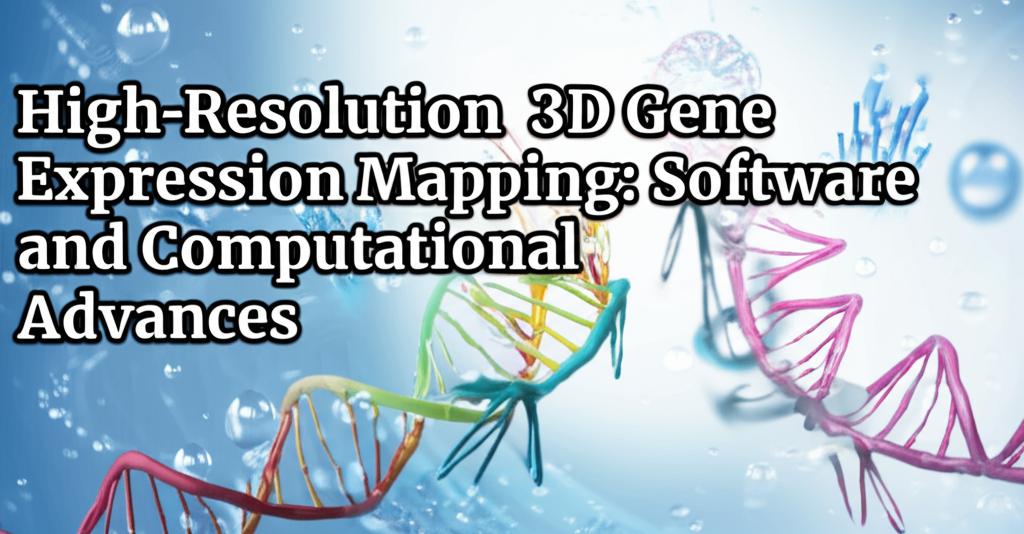The field of high-resolution 3D gene expression mapping is rapidly evolving, driven by innovations in both software and computational methodologies. These advancements are providing researchers with unprecedented insights into the spatial organization of gene activity within tissues, transforming our understanding of complex biological systems in development, disease, and regenerative medicine.
New Software Tools Democratizing 3D Gene Expression Analysis
A significant challenge in 3D gene expression mapping has been the complex data processing and computational expertise required. Addressing this, researchers are developing user-friendly software solutions.
One notable example is tomoseqr, a software tool developed by researchers at the University of Tsukuba. Released in early 2025, tomoseqr simplifies the estimation of 3D spatial gene expression distribution. It utilizes RNA tomography data – generated by sequencing frozen tissue sections along three orthogonal axes and computationally reconstructing a 3D map. Tomoseqr features an intuitive graphical user interface (GUI) that streamlines the creation of tissue morphology data and allows for the visualization of 3D gene expression models. Importantly, it is freely available and has been integrated into Bioconductor, a widely used platform for life science software, making it accessible to a broad research community. Studies using tomoseqr on zebrafish and planarians have validated its accuracy in reproducing known gene expression patterns and mapping the 3D spatial distribution of thousands of genes.
Another software, BioLayout Express3D, is designed for the integration, visualization, and analysis of large network graphs derived from biological data, including gene expression. It offers capabilities to display and cluster large graphs in both 2D and 3D, aiding in the interpretation of complex gene expression networks.
Computational Advances: Deep Learning and Enhanced Resolution
Computational approaches, particularly those leveraging deep learning, are pushing the boundaries of resolution and predictive power in 3D gene expression mapping.
Cleopatra, an attention-based deep learning model, represents a significant step forward. Introduced in early 2025, Cleopatra integrates ultra-deep Region Capture Micro-C (RCMC) and Micro-C data with epigenomic inputs. It is pre-trained on genome-wide Micro-C data and then fine-tuned with high-resolution RCMC data. This allows Cleopatra to predict 3D contact maps at sub-kilobase bin sizes with unprecedented resolution. Application of Cleopatra to human cell types has revealed cell-type-specific microcompartments and a vast number of loops, many of which are cell-type-specific. These findings highlight the association between chromatin looping and higher gene expression and help nominate new transcription factors involved in cell-type-specific enhancer-promoter interactions. X-Pression, another deep convolutional neural network-based framework, reconstructs 3D expression signatures of cellular niches from volumetric microcomputed tomography (micro-CT) data. This approach offers a scalable and cost-effective alternative for exploring the 3D transcriptional landscape of tissues non-destructively, overcoming limitations of traditional 2D sectioning methods. X-Pression has demonstrated its utility in visualizing complex spatial relationships in studies of SARS-CoV-2 infection, disease progression, and vaccine efficacy.The pC-SAC (probabilistically Constrained Self-Avoiding Chromatin) method, introduced in April 2025, focuses on producing accurate high-resolution Hi-C matrices from low-resolution data. By using adaptive importance sampling with sequential Monte Carlo, pC-SAC generates ensembles of 3D chromatin chains that satisfy physical constraints, achieving high accuracy in reconstructing chromatin maps and identifying novel interactions.
SpatioCell is a deep learning algorithm designed for high-resolution single-cell mapping. It integrates imaging data-derived morphological features with transcriptomic measurements. SpatioCell combines automated adaptive prompting with an optimized vision model for cell segmentation and morphological analysis, followed by dynamic programming to optimize cell-type assignments. This approach has shown superior performance in nuclear segmentation and cell annotation accuracy across various cancer types, revealing fine details of the tumor microenvironment.Addressing Challenges and Future Directions
Despite these advancements, challenges remain. Batch effects in spatial transcriptomics data, arising from technical variability across different experiments or platforms, can obscure true biological signals. Researchers are actively developing and benchmarking computational methods for batch effect correction, alignment, and integration of data from multiple sources. Methods like SLAT, GraphST, PRECAST, SPIRAL, and STAligner are being evaluated for their effectiveness in various settings.
The integration of multi-omics data – combining spatial transcriptomics with proteomics, epigenomics, and other data types – is a key area of future development. This holistic approach promises a more comprehensive understanding of cellular function and tissue architecture.
Furthermore, enhancing the resolution of spatial transcriptomics techniques to subcellular levels while maintaining high throughput remains a significant goal. Technologies like Seq-Scope, offering sub-micron resolution, and advancements in Slide-seq (e.g., Slide-seqV2 with increased capture efficiency) are paving the way.
Computational tools for downstream analysis are also crucial. This includes methods for cell type annotation, spatial clustering, detection of spatially variable genes, and analysis of cell-cell interactions. Software like STUtility provides functionalities for processing image data, aligning consecutive tissue images for 3D visualization, and identifying neighboring capture spots in spatial networks.
In summary, the field of high-resolution 3D gene expression mapping is experiencing a surge of innovation. User-friendly software is democratizing access to these powerful techniques, while sophisticated computational methods, especially deep learning, are dramatically increasing the resolution and analytical depth. These advancements are poised to unlock new discoveries in fundamental biology and drive progress in translational research, particularly in understanding complex diseases like cancer and neurological disorders.

